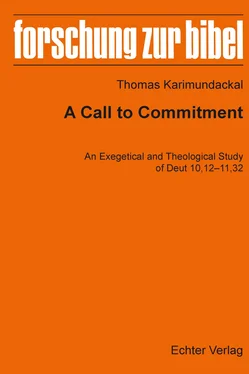• In 11,22a the LXX’s reading of שׁמר תשׁמרון is more theological in nature. The MT has the verbal structure שׁמר תשׁמרון but the LXX has ἀκοῇ ἀκούσητε. The LXX follows closely 11,13 and replaces שׁמר תשׁמרון with שׁמע תשׁמעו, making 11,22-25 parallel to 11,13-21, whereas, the MT’s usage is in tune with 6,17. Thus, the LXX makes a change in the verb שׁמע/שׁמר probably to indicate that by obeying the commandments Israel will not only gain prosperity and longevity but will also conquer the promised land. 149
3.4.3 Alterations by additions
At times the LXX introduces certain interpretative elements into the text. These elements are evident in the addition of certain words or phrases. 150For example:
• In 10,13a the LXX adds κυρίου τοῦ θεοῦ σου to define the personal relationship to the Lord and the individual commitment of the Israelites.
• In 10,15a the LXX uses an adverbial conjunction πλὴν to denote a contrast. The LXX also differentiates the meaning of חשׁק by using a compound verb προείλατο …. ἀγαπᾶν “to choose to love” and then ἐξελέξατο to render יבחר.
• In 10,18a the LXX corresponds to the traditional trio format ,אלמנה גר ,יתום (cf. 14,28; 16,11.14; 24,17.19.20.21; 26,12.13). The MT lacks גר in 10,18a but places it in the second part of the verse.
• In 11,7 the LXX expands the MT to interpret the Lord’s great deeds as a permanent reality. The MT refers to את־כל־מעשׂה יהוה הגדל אשׁר עשׂה. The LXX not only changes into the plural (πάντα τὰ ἔργα κυρίου τὰ μεγάλα) but also adds to the relative clause ὅσα ἐποίησεν ὑμῖν σήμερον. The addition of the pronoun could be taken as a construction ad sensum but the addition of σήμερον is meant to take ἐποίησεν as a present reality.
• The MT’s ולמדתם אתם את־בניכם at 11,19a is interpreted by adding a complementary infinitive λαλεῖν.
3.4.4 Linguistic corrections
At times the LXX makes some grammatical changes to bring out more clarity. For example:
• In 11,10f the LXX changes the verb into the third person plural for the entire ὅταν clause (ὅταν σπείρωσιν τὸν σπόρον καὶ ποτίζωσιν τοῖς ποσὶν ὡσεὶ κῆπον λαχανείας), referring to all Egyptians. 151
• In11,14a the LXX’s treatment of the bound phrase מטר־ארצכם in the dative (ὑετὸν τῇ γῇ σου) makes sense since the rain is ‘for the ground’ and not ‘of the ground’.
• In 11,15 the narrative sequence witnesses to another shift from 15b as it renders the second person singular ואכלת ושׂבעת. The LXX makes use of the participles φαγὼν and ἐμπλησθεὶς for these finite verbs and subordinates them to πρόσεχε in v16. Though השׁמרו is plural in the MT, the LXX does not change it to the plural until v16b with παραβῆτε.
• In 11,20a the LXX changes the singular format of the verse into the plural. For example, the LXX reads וכתבתם as plural (γράψετε) and adds αὐτὰ ad sensum . The plural usage is also continued in the plural pronouns: τῶν οἰκιῶν ὑμῶν and τῶν πυλῶν ὑμῶν. Naturally, the plural sequence of 6,9 is followed in these instances. 152
Summary: The MT and the LXX in most parts resemble each other in terms of the content, sequence and the word order. The variant readings in the LXX mostly reflect its tendency to harmonize and to make interpretative notes. The interpretative and explanatory elements in the LXX mostly bring out the the theology of the translators’ time. In short, the LXX variants, when used intelligently, can become an important aid for understanding the Hebrew text. 153
3.5 Observations on the MT and the Qumran texts
The Qumran manuscripts, of course, are by no means flawless, but they help us to demonstrate the adequacy of the MT. A comparison of the Qumran texts with the MT gives us a better perspective on the textual variants. 154Most of the textual variants in the Qumran texts come either from orthographical differences or from their tendency to harmonize the text with the Smr and the LXX or from certain linguistic corrections.
3.5.1 Orthographical changes
The Qumran profile shows many variations and most of them are due to the orthographical features of the Qumran texts. Although the orthography of Qumran texts is usually close to that of the MT, there are certain orthographical patterns which distinguish Qumran texts from the MT. 155For example, 4QDeut k1, 4QDeut cand 4QPhyl ause a fairly full orthography with certain specific characteristics. 156In 4QDeut k1:
• A waw is generally used to mark ā → o when it is accented (11,10c לא ,לוא [MT]; 11,11a ובקעת ,ובקעות [MT]) or unaccented (11,9b לאבתיכם ,לאבותיכם [MT]; 11,12a אלהיך ,אלוהיכה [MT]).
• u → o is also marked with a waw in both accented and unaccented syllables (unaccented, 11,6 passim כל ,כול [MT]; 11,7a הגדל ,הגדולים [MT])
• While the afformative of the perfect in the singular is sometimes written in the longer form (11,10f והשׁקית ,והשׁקיתה [MT]), the afformative in the plural is written in the shorter form (11,8f ,עוברים עברים [MT]; 11,10d יצאתם ,יצאתם [MT]).
• The singular pronominal suffix is written in the longer form (11,10f ברגלך ,ברגליכה [MT]; 11,12a אלהיך ,אלוהיכה [MT]).
• Independent pronouns are written in the long form (11,10b ,אתמה אתה [MT]; 11,10c הוא ,היאה [MT]).
• In 11,10a כיא is written with a double mater lectionis (כי MT). 157
Similar orthographical patterns can be seen in 4QDeut cand 4QPhyl a: 4QDeut c→ 11,10f ברגלך ,ברגליך [MT]; 11,12a אתה ,אותה [MT]; 11,13a, שׁמע ,שׁמוע [MT]; 4QPhyl a→ 10,22a מצרימה ,מצרים [MT]; 11,17e מהרה ,מהר [MT]; 11,21a על ,מעל [MT].
3.5.2 Harmonizing alterations
Another dominant feature of the Qumran variant readings is their harmonizing tendency, especially to harmonize the text with another biblical passage.
• In 10,13a 8QPhyl, 8Qmez, 4QPhyl aand 4QPhyl kadd אלהיך to harmonize with the formula “the Lord your God” (cf. 4,2; 6,17; 8,6; 11,27.28; 28,9.13).
• In 10,16a 8QMez has the plural ערלות to synchronize with לבבכם instead of the MT’s ערלת.
• In 10,18b 4QPhyl kcorresponds with the traditional triad format גר ,יתום ,אלמנה as in 14,29; 16,11.14; 24,17.19.20.21; 26,12.13; 27, 19. 158
• In 11,6a 4QPhyl k, 4QPhyl aand 8QMez read ואת כל־האדם אשׁר לקרח as in Num 16,32. 159
• In 11,8f 1QPhyl, 4QPhyl a, 8QPhyl, 8QMez have באים שׁמה as in 4,5; 30,18 instead of MT’s עברים שׁמה.
3.5.3 Resemblance to the LXX and the Smr
Another significant feature of the Qumran variants is their close resemblance to the LXX 160and the Smr. Unique links between the Qumran texts and the LXX and the Smr illuminate one another in regard to their linguistic features. 161
• In 10,17b 4QPhyl khas singular האדון as in the case of the Smr.
• In 10,18b 4QPhyl khas the traditional triad format גר ,יתום ,אלמנה as in the LXX.
• In 11,4a 4QPhyl k, 4QPhyl aand 8QMez read לסוסיו ולרכבו corresponding to the LXX. 162
• In 11,6a 4QPhyl k, 4QPhyl aand 8QMez have ואת כל־האדם אשׁר לקרח as in the Smr.
• In 11,8f 1QPhyl, 4QPhy la, 8QPhyl, 8QMez have באים שׁמה as in the Smr instead of the MT’s 163.עברים שׁמה
Читать дальше












